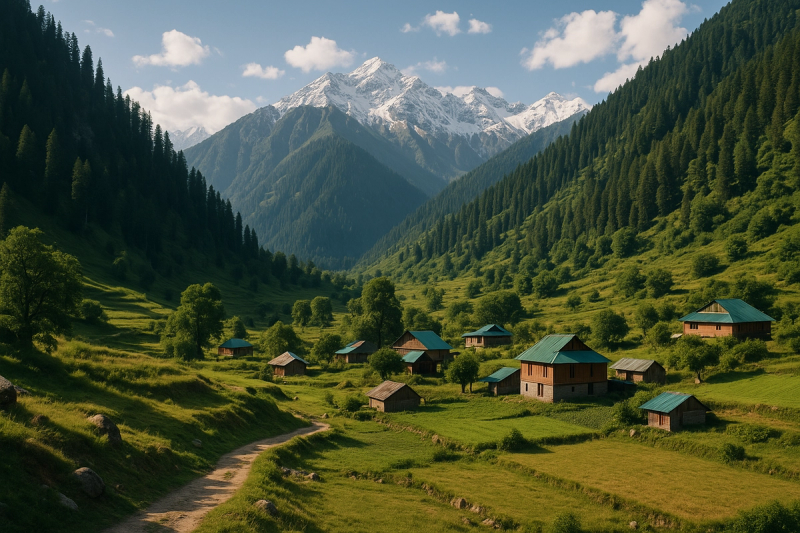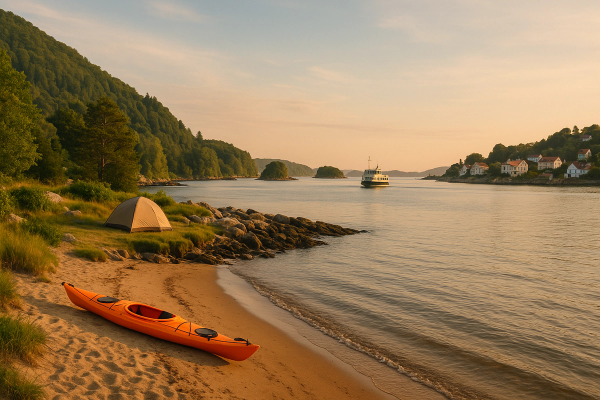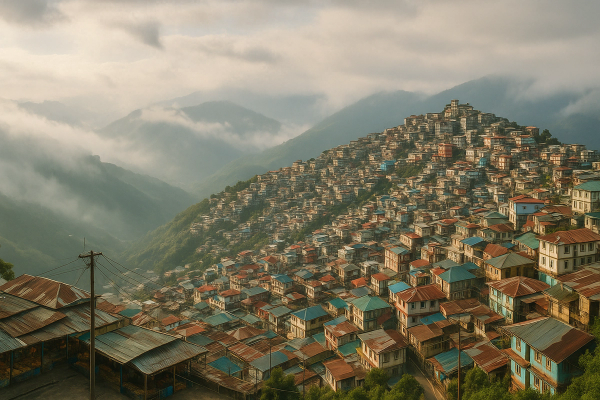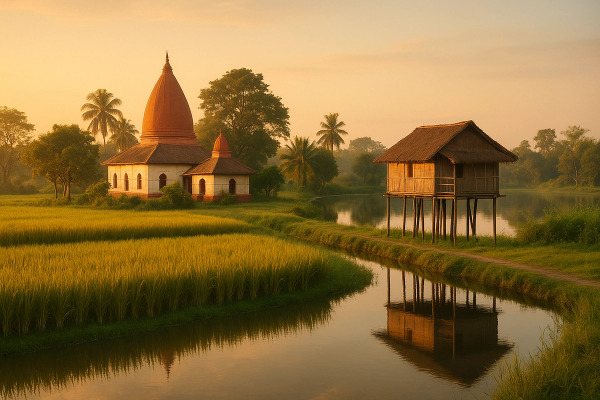Hidden Gems of Kashmir: Offbeat Destinations & Secret Villages – A Desi Traveler’s messy love letter#
I’m just gonna say it—Kashmir got under my skin. Not the postcard Dal Lake stuff, I mean the quiet valleys, sleepy villages, the namda rugs half drying on fences, kids shouting “salaam!” and running away giggling. I went chasing the offbeat side, you know, the secret corners locals casually mention with a smile. And then I didn’t wanna leave. Typical.¶
Gurez & Tulail: where the mountains whisper in Kishanganga’s tone#
So, Gurez. Bro, it’s wild-beautiful. You cross Razdan Pass from Bandipora (it usually opens late May or June, closes again with snow by November). I was in a shared Sumo where Farooq bhai drove like it’s his own backyard road. ID checks at a couple of points, no drama, carry your Aadhaar. As we rolled into Dawar, the river looked like melted sapphire. Tulail—Sheikhpora, Purana Tulail—even quieter. No honking, no Insta crowd, just apple trees and wooden homes, roofs that look like they’ve fought a hundred winters.¶
I stayed at a homestay run by one Uncle Bashir, who insisted I eat trout like I haven’t eaten in five years. Noon chai at 5 pm, because time doesn’t matter here. At night the stars. I swear, I felt small and big at the same time. No fancy cafes, but simple wazwan plates, haakh, nadru yakhni, roti so soft I almost cried. Tulail felt extra remote—network kept playing hide and seek. If you’re working remote, forget it. Just be present, yaar.¶
- Travel tip: Check road status the day before. Razdan can shut with sudden weather. J&K Traffic Police posts daily updates for NH44 and interior routes on social channels.
- Stay: Homestays 900–2000 INR per night, mostly basic, warm, clean. Book in advance after the pass opens, June-Aug peak. Electricity is fine but carry a power bank.
- Permits: Indian nationals generally okay with ID at checkposts. Foreign travelers—rules can be tricky near LoC. Please confirm with District Administration Bandipora well before.
Bangus & Lolab: meadows where you go “arre yaar, how is this even real?”#
Kupwara side—Bangus Valley is like somebody ironed the earth and made it green forever. Early July to September, you get meadow bloom, crisp air, and silence that thuds in your ear. Some stretches need permission or at least a nod from local army posts. Keep your ID handy. There’s even a Bangus Festival some summers, local music and food, very vibe-y.¶
Nearby Lolab, the “Lolab valley of dreams” people say, feels lived-in. I walked into a tiny village bakery and the guy gave me tsot bread straight off the tandoor, aah. Homestays here are getting better—think 1200–2500 INR, and a few cottage stays slightly higher. Best part? Nobody’s rushing you. Just walk. Talk. Don’t overplan. The best scene was me and Adil, a local student, chasing light through poplar trees after rain. The smell… can’t explain it right.¶
Keran on the Kishanganga: postcard edges, real-life patience#
Keran is stunning, like painfully beautiful. It’s right along the river that draws a line on a map, so security is tight. You’ll cross multiple checkposts, show ID, and get told kindly to not fly drones or click border posts. Please respect that. I stayed in a small lodge, 1500 INR, view so dramatic my phone battery suffered.¶
Sunrise hits slow here. Locals say best time is spring to early autumn. Winters are harsh, and roads do feel risky with ice, so honestly don’t push it. Food’s simple, everyone’s friendly in a slightly cautious way. Nothing loud. You go quiet by default.¶
Warwan Valley: the legends are true, but the road… umm patience, buddy#
Warwan sits in Kishtwar region, and getting there is half the story. Road conditions change like mood swings. Peak months—August to September—after snowmelt when trails open. Shared cabs via Anantnag/Kokernag side to Inshan, then hamlets like Afti, Margi. You’ll hear “trek” more than “drive.” I hitched a ride with a truck once. Felt like a movie but yeah, dusty nose.¶
Stay options are very limited—homestays, 800–1500 INR, basic rooms with quilts that look like they’ve lived whole lifetimes. Food’s dal, rice, local veggies, sometimes mutton if you’re lucky. This valley… it reminds you nature doesn’t care about your itinerary. No network in long stretches. Take cash. Say thanks a lot.¶
South Kashmir’s softer secrets: Yousmarg, Doodhpathri, Aharbal, Daksum, Chatpal#
These places are closer to Srinagar but still feel offbeat if you time it right. Yousmarg and Doodhpathri are meadow dreams. On weekdays, early mornings, it’s just you and pine smell. In winter, they turn white and unreal—roads mostly open but weather can mess plans. Aharbal waterfall thunders like it’s angry at the world—late spring is grand. Daksum is my chill corner—wooded, trout streams, picnic forever. Chatpal near Anantnag is still a bit secret—pastures, slow villages, elderly folks who chuckle at city kids.¶
Quick local trick: don’t only go when it’s “perfect season.” April brings apple blossoms, October gives chinar leaves burning red-gold, and honestly that moody shoulder season light… best for photos. I got my favorite shot in late October when everyone else ran toward Gulmarg.¶
How to move around without losing your mind#
Fly into Srinagar, then it’s shared Sumos and local buses. Sumo stands at Parimpora and other hubs dispatch like clockwork—Bandipora, Kupwara, Shopian, Kulgam, Anantnag routes spread all day. Fares 200–600 INR depending on distance. Private taxis are comfy but can bite the budget—full-day 2500–4500 INR typical, more for remote. If you self-drive, start early, avoid night drives. Landslides and stray livestock don’t care for headlights. Download offline maps. And chai breaks are compulsory.¶
- Network: Jio is decent around towns, patchy in deep valleys. BSNL exists but don’t depend on it like lifeline. Carry two Sims if you can.
- Cash vs UPI: UPI is everywhere near Srinagar and main towns. Remote villages—cash still king. ATMs sparse. Keep enough backup for two extra days, just in case.
- Fuel: Srinagar and district HQs fine. Remote stretches—top up whenever you can. Don’t play macho with the meter.
Safety, permits, and the feel of now#
Things change fast in the Valley. As of 2025, most tourist circuits are stable, day-to-day life normal, but occasional bandhs or security advisories still happen. No big deal if you plan smart. Always carry ID, don’t photograph military posts, and don’t wander into restricted zones just for a reel. Check local news, ask your homestay host, call it a day if folks say stay indoors.¶
Border-side spots like Keran, Tangdhar, Machil might have extra checks. Some meadows around Bangus and certain trails require informal permissions at posts—this is routine. Be polite, answer questions, smile. Drones and fancy camera rigs can be sensitive; better leave the drone at home unless you have written permission. And btw, weather is boss. Pack layers, rain cover, sunscreen. You’ll need all of it in the same day, weirdly.¶
Where to stay and what it costs—no sugarcoating#
Srinagar has everything from houseboats to boutique stays. 2000–8000 INR a night for decent midrange. But for this offbeat hunt, homestays rule. In Gurez, Lolab, Keran, Warwan—think 800–2500 INR. The vibe is family-run, simple bedding, hearty food, hot water sometimes from a bucket, and a bonfire if you become friends. You will. Apps now list many of these stays, but call directly if you can. Hosts respond faster, and you’ll get directions that actually work.¶
If you want nicer cottages, Yousmarg and Doodhpathri have tourism huts and private lodges around 2500–4500 INR. On weekends prices spike. Book weekdays. Shoulder season hacks save money and your nerves.¶
Food that makes you weak in the knees#
Kashmiri food is… warm. That’s the word. Wazwan spreads are famous—rogan josh, rista, gushtaba, yakhni—slow-cooked, fragrant. In villages, the simple stuff killed me. Haakh with rice, nadru yakhni, mutton curry that tastes like someone’s Nani made it. Trout in Daksum or Gurez—grilled, lemon, salt. Breakfast breads—tsot, girda, sheermal—and noon chai with salt, kahwa with almonds when the wind chills your bones.¶
Tip for vegetarians: you’re covered. Loads of local greens, paneer, dal. Tell your host beforehand if you don’t eat meat, they’ll plan. And please eat where villagers eat. The fancy places are fine, but the tiny kitchen behind the wood stack? That’s the memory.¶
Seasons: what works when, and what’s secretly best#
June–September is the safest bet for high valleys like Gurez, Bangus, Warwan. Spring—April–May—blossoms, milder trails, rushing rivers. Autumn—September–October—chinar leaves and warm afternoons. Winter—December–February—snow dreams near Yousmarg, Doodhpathri, Aharbal, but remote passes shut. If you’re snow-chasing, be flexible with dates. Power outages happen, roads update daily. Again, check locally, don’t overcommit to rigid plans.¶
Small mistakes I made so you don’t have to#
- Overpacking city clothes. Nobody cares. Pack layers, waterproof shoes, one good fleece, a rain shell.
- Not carrying snacks. Villages have shops but you’ll crave quick munch. Nuts, chikki, a few ORS sachets—lifesavers.
- Ignoring altitude and sun. I got toasted at 3000m without sunscreen. Wear a cap. Drink water. Take it chill.
- Not keeping enough cash. UPI failed once in Tulail. The shopkeeper said, “kal ho jayega.” It didn’t.
- Trying to night-drive a mountain road. Bad idea. Start early, end early.
People, culture, and the warm bits you can’t put on an itinerary#
I remember a family in Lolab inviting me in because I looked lost. The grandpa in a pheran told me stories about winter schools and migrating flocks, while we crushed walnuts like a ritual. In Keran a kid traded a pebble for my keychain. In Gurez a teacher asked me about my city, then laughed, “Here, mountains do the teaching.” These small kindnesses—they make you stay longer than you planned.¶
Please dress modest when in villages. Ask before clicking portraits. Learn two Kashmiri phrases—“khush pakh” for good wishes, “meharbani” for thanks. You’ll see doors open wide.¶
Ongoing vibes and local events#
Summer often brings small district festivals—Bangus Festival, and Gurez cultural days with folk music, horse shows, food stalls. Nothing Massive, but very fun. Dates vary year to year. J&K Tourism social pages announce stuff close to time. Don’t plan only for events, but if you’re around, drop in, clap louder than you think is polite.¶
Would I go back?#
Obviously. I didn’t even finish half my list. Kupwara side still has corners I haven’t seen. Warwan deserves a longer stay. Tulail… that place lives in my head rent-free. Next time I’ll slow down more. No rush. Just longer walks and extra kahwa and that late-afternoon sun that makes every village look like a childhood story.¶
Final travel thoughts#
If you’re an Indian traveler itching for real quiet and authentic mountain-life, these offbeat Kashmir gems are gold. It’s not luxury, it’s not perfect, some days things won’t work, and honestly that’s why it works. Go gentle. Spend money locally. Leave no litter. Carry patience. You’ll recieve more than you expected… trust me. And hey—if you want more raw travel notes and practical guides, I keep finding good stuff on AllBlogs.in. Check it out, bookmark a few, go pack.¶














